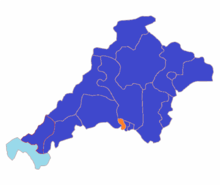St Ives by-election, 1928

The St Ives by-election, 1928 was a by-election held on 6 March 1928 for the British House of Commons constituency of St Ives in Cornwall.
Vacancy
The by-election was caused by the resignation of the sitting Conservative Party Member of Parliament (MP) Anthony Hawke on his appointment to be a High Court judge.
Electoral history
Hawke had first won the seat at the 1922 general election. He lost it to the Liberal candidate Sir Clifford Cory at the 1923 general election when there was also a Labour candidate in the field but won it back from Cory in a straight fight in 1924.
| Party | Candidate | Votes | % | ± | |
|---|---|---|---|---|---|
| Conservative | John Anthony Hawke | 11,159 | 53.0 | +12.4 | |
| Liberal | Sir Clifford Cory | 9,912 | 47.0 | +0.5 | |
| Majority | 1,247 | 6.0 | 11.9 | ||
| Turnout | 21,071 | 69.1 | -2.3 | ||
| Conservative gain from Liberal | Swing | +4.6 | |||
Candidates
- The Conservatives picked Sir Andrew Caird (1870-1956) one of Lord Northcliffe’s newspaper editors and directors [2] to defend the seat.
- The Liberal Party challenger was Hilda Runciman, the wife of leading Liberal MP, Rt Hon. Walter Runciman.
- The Reverend Frederick Hopkins, intervened for the Labour Party.
Campaign
The by-election was a three-cornered contest, though given the electoral history of the seat it was always regarded as a two-horse race between Conservative and Liberal.
The circumstances in which Mrs Runciman came to be selected as Liberal candidate were an issue in the by-election. Her husband, Walter Runciman who was Liberal MP for Swansea West had decided to transfer from Swansea to St Ives at the next general election. When the by-election was caused by Hawke’s resignation, Mrs Runciman was adopted as Liberal candidate to keep the seat warm for her husband. This attracted Tory derision.[3] Apparently Liberal party leader David Lloyd George did not approve of Mrs Runciman’s candidacy and he sent no message of support for her during the by-election. However, Deputy Leader Sir Herbert Samuel did travel to the constituency to speak on her behalf.[4]
Result
The result was a victory for Mrs Runciman, who overturned Hawke’s majority of 1,247 to win by a majority of 763 votes.
| Party | Candidate | Votes | % | ± | |
|---|---|---|---|---|---|
| Liberal | Hilda Runciman | 10,241 | 42.6 | -4.4 | |
| Conservative | Sir Andrew Caird | 9,478 | 39.4 | -13.6 | |
| Labour | Rev. Frederick Jesse Hopkins | 4,343 | 18.0 | n/a | |
| Majority | 763 | 3.2 | 9.2 | ||
| Turnout | 24,062 | 77.4 | +8.3 | ||
| Liberal gain from Conservative | Swing | +4.6 | |||
Mrs Runciman was the third woman parliamentary candidate ever to be elected for the Liberal Party, after Margaret Wintringham and Vera Terrington. On election Mrs Runciman joined her husband in the House of Commons, the first married couple to sit in the House together.[6]
Aftermath
Mrs. Runciman duly stood down in her husband’s favour at the 1929 general election and he held the seat for the Liberal Party, again defeating Caird.
| Party | Candidate | Votes | % | ± | |
|---|---|---|---|---|---|
| Liberal | Rt Hon. Walter Runciman | 12,433 | 43.2 | +0.6 | |
| Conservative | Sir Andrew Caird | 11,411 | 39.7 | +.3 | |
| Labour | W E Arnold-Forster | 4,920 | 17.1 | -0.9 | |
| Majority | 1,032 | 3.5 | +0.3 | ||
| Turnout | 28,764 | 76.5 | -0.9 | ||
| Liberal hold | Swing | +0.15 | |||
Mrs Runciman sought re-election at the General Election of 1929 at the Conservative held seat of Tavistock, but finished second. Rev. Hopkins also moved to contest Penryn & Falmouth and again finished third.
This was seen as one of the two ‘warming pan’ by-elections in the 1924-1929 Parliament, with Hugh Dalton's wife successfully contested the 1929 Bishop Auckland by-election with her husband contesting it at the 1929 general election.[8]
References
- ↑ British parliamentary election results 1918-1949, Craig
- ↑ The Times, 17 December 1956
- ↑ Roy Douglas, Liberals: The History of the Liberal and Liberal Democrat Parties; Hambledon and London, 2005 p215
- ↑ Pamela Brookes, Women at Westminster; Peter Davies Publishing, 1967 p65
- ↑ British parliamentary election results 1918-1949, Craig
- ↑ Brookes, op cit p65
- ↑ British parliamentary election results 1918-1949, Craig
- ↑ Brookes, op cit p65-66
- Craig, F. W. S. (1969) [1969]. British parliamentary election results 1918-1949 (1st ed.). Glasgow: Parliamentary Research Services. ISBN 0-900178-01-9.
- Leigh Rayment's Peerage Pages